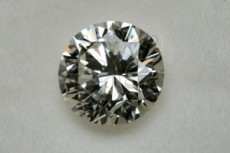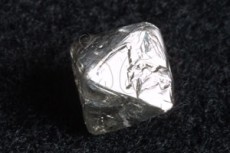|
01 Basic information
Diamond is the hardest known mineral on Earth. Its name means “hardest” in Arabic. Its main constituent is carbon, and may sometimes contain trace amounts of silicon, aluminum, calcium, magnesium, iron, nitrogen or boron. Diamond belongs to the isometric crystal family, and its crystal habit is octahedral. Diamonds of high purity is colorless and transparent, although some with trace amounts of impurities may produce colored diamonds, such as blue (boron), yellow (nitrogen), and pink (manganese).
Because diamonds have high refractive indices, a specimen that is cut proportionally will exhibit total internal reflection and produces brilliant specks of lights, referred to as “fire.” A perfectly cut diamond with 58 facets will produce shadow patterns shaped like arrows and hearts. This type of cut is known as “Hearts and Arrows”, also known as “Cupit” cut.
Sometimes diamonds may include small materials of various types. Some of the common inclusions are pyropes, enstatites, spinels, graphites or small diamonds. The amount of inclusions in a diamond determines its degree of clarity.
 |

|
|
A specimen that is cut
proportionally will exhibit
total internal reflection.
|
This diamond produces
brilliant specks of lights,
referred to as “fire.”
|
|

|
|
|
Diamond’s crystal habit is
octahedral.
|
|
02 Occurrence
Diamonds are produced under environments of extreme temperatures (over 1500°C) and pressure (above 50,000 atm) deep below Earth’s crust (150-300 kilometers). To find diamonds near surface of the Earth, only those produced in 200 km deep Kimberlites and Peridotites are possible; no diamonds are found in basaltic rocks and andesites that are formed under 30,000 atm. Diamonds may also be found in areas of high pressure metamorphic rocks, but their granule diameters are too small to be made into jewels.
|

|
| Diamond in brecciated mica peridotite |
03 Important deposits
India is one of the earliest countries that produce gem grade diamonds, and many historically famous specimens came from India. The famous blue diamond, the Hope Diamond, is one such example. Before 19th Century, the main sources of diamonds come from India and Brazil. After 1867, the discovery of alluvial sand deposits and native Kimberlite rock pipes in South Africa made it one of the most important diamond producing nations in the world. In 1985, new diamond mines were discovered in the Argyle regions of middle Australia, and production of diamonds from Australia quickly rose to first place in the world in 1986; however, only 5% of diamonds produced are of gem quality. To date, the five major diamond export countries in the world are Australia, Zaire, Botswana, Russia and South Africa, accounting for 90% of annual global diamond productions.
04 Trivia
To invest in diamonds, it is best to purchase them with certificates from international appraisal authorities such as GIA and HRD. The larger the carat the more valuable it is. If budget is limited, one can select Color grading of G, H, I (near color less) and Purity grading between VS and SI, where inclusions are invisible to the naked eye. A diamond that is properly cut retains its brilliance at a fraction of price of more expensive varieties, such as the Hearts and arrows (Cupit) cut.
The largest original diamond crystal on record was the Cullinan Diamond, weighing at 3106 carats and was found in the Premier Mine of South Africa in 1905. After cutting and refining, the Cullinan produced 9 larger diamonds and 96 smaller diamonds. The largest of them (Cullinan I) is encased on the Sceptre with the Cross, Britian’s Crown Jewel. Weighing at 530.2 carat, the Cullinan I is also known as “The Great Star of Africa”.
The Hope Diamond was produced in India during the 17th Century. The original crystal weighed 112.18 carats and was further refined to the present weight of 45.52 carats. The Hope Diamond is the world largest blue diamond, and is now on display in the Museum of Natural History at the Smithsonian Institute, United States.
The international digital archives and e-learning communication project of the National Museum of Natural Science
National Museum of Natural Science
|
















